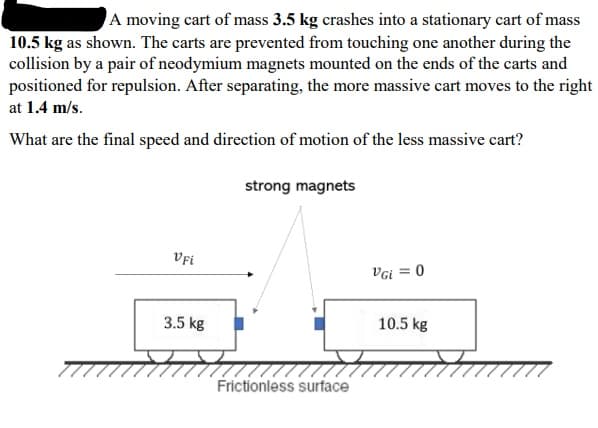A moving cart of mass 3.5 kg crashes into a stationary cart of mass 10.5 kg as shown. The carts are prevented from touching one another during the collision by a pair of neodymium magnets mounted on the ends of the carts and positioned for repulsion. After separating, the more massive cart moves to the right at 1.4 m/s. What are the final speed and direction of motion of the less massive cart? strong magnets VFi VGi = 0 3.5 kg 10.5 kg Frictionless surface
A moving cart of mass 3.5 kg crashes into a stationary cart of mass 10.5 kg as shown. The carts are prevented from touching one another during the collision by a pair of neodymium magnets mounted on the ends of the carts and positioned for repulsion. After separating, the more massive cart moves to the right at 1.4 m/s. What are the final speed and direction of motion of the less massive cart? strong magnets VFi VGi = 0 3.5 kg 10.5 kg Frictionless surface
University Physics Volume 1
18th Edition
ISBN:9781938168277
Author:William Moebs, Samuel J. Ling, Jeff Sanny
Publisher:William Moebs, Samuel J. Ling, Jeff Sanny
Chapter9: Linear Momentum And Collisions
Section: Chapter Questions
Problem 96AP: Two carts on a straight track collide head on. The first cart was moving at 3.6 m/s in the positive...
Related questions
Topic Video
Question

Transcribed Image Text:A moving cart of mass 3.5 kg crashes into a stationary cart of mass
10.5 kg as shown. The carts are prevented from touching one another during the
collision by a pair of neodymium magnets mounted on the ends of the carts and
positioned for repulsion. After separating, the more massive cart moves to the right
at 1.4 m/s.
What are the final speed and direction of motion of the less massive cart?
strong magnets
Vfi
VGi = 0
3.5 kg
10.5 kg
Frictionless surface
Expert Solution
This question has been solved!
Explore an expertly crafted, step-by-step solution for a thorough understanding of key concepts.
This is a popular solution!
Trending now
This is a popular solution!
Step by step
Solved in 2 steps

Follow-up Questions
Read through expert solutions to related follow-up questions below.
Follow-up Question
So even if the cart on the left has a smaller mass it moves to the left at the same velocity as the larger mass?
Solution
Knowledge Booster
Learn more about
Need a deep-dive on the concept behind this application? Look no further. Learn more about this topic, physics and related others by exploring similar questions and additional content below.Recommended textbooks for you

University Physics Volume 1
Physics
ISBN:
9781938168277
Author:
William Moebs, Samuel J. Ling, Jeff Sanny
Publisher:
OpenStax - Rice University

Physics for Scientists and Engineers: Foundations…
Physics
ISBN:
9781133939146
Author:
Katz, Debora M.
Publisher:
Cengage Learning

Glencoe Physics: Principles and Problems, Student…
Physics
ISBN:
9780078807213
Author:
Paul W. Zitzewitz
Publisher:
Glencoe/McGraw-Hill

University Physics Volume 1
Physics
ISBN:
9781938168277
Author:
William Moebs, Samuel J. Ling, Jeff Sanny
Publisher:
OpenStax - Rice University

Physics for Scientists and Engineers: Foundations…
Physics
ISBN:
9781133939146
Author:
Katz, Debora M.
Publisher:
Cengage Learning

Glencoe Physics: Principles and Problems, Student…
Physics
ISBN:
9780078807213
Author:
Paul W. Zitzewitz
Publisher:
Glencoe/McGraw-Hill

Modern Physics
Physics
ISBN:
9781111794378
Author:
Raymond A. Serway, Clement J. Moses, Curt A. Moyer
Publisher:
Cengage Learning

Principles of Physics: A Calculus-Based Text
Physics
ISBN:
9781133104261
Author:
Raymond A. Serway, John W. Jewett
Publisher:
Cengage Learning

Classical Dynamics of Particles and Systems
Physics
ISBN:
9780534408961
Author:
Stephen T. Thornton, Jerry B. Marion
Publisher:
Cengage Learning